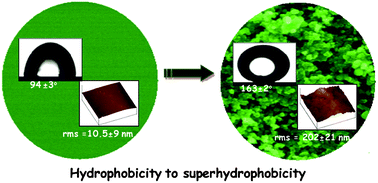In this study, a novel fluorinated polybenzoxazine (PBZ) is successfully designed for the first time to fabricate superhydrophobic films on a glass surface. 2,2-Bis(3-fluorophenyl-3,4-dihydro-2H-1,3-benzoxazinyl)hexafluoro propane (BAF-fa) is successfully synthesized utilizing a conventional one-pot Mannich reaction. The transformation of the polymeric film of BAF-fa from hydrophobic to superhydrophobic has been achieved with silica modification, thus showing the involvement of the phenomena of low surface free energy and surface roughness combined. The method to fabricate uniform hybrid films resulted in a water contact angle (WCA) of 163°, and possesses the advantages of being straightforward and inexpensive. Morphological studies have revealed the induced hierarchical roughness of the hybrid films over multiple scales. The as-prepared hybrid films are superhydrophobic not only for neutral water, but also for water with a wide pH range. Additionally, these hybrid superhydrophobic films have shown promising durability in tap water and ethanol at different temperatures. This finding provides an effortless method to fabricate sliding superhydrophobic surfaces with high durability, thus expanding the role of PBZ in super water-repellency.

You have access to this article
 Please wait while we load your content...
Something went wrong. Try again?
Please wait while we load your content...
Something went wrong. Try again?


 Please wait while we load your content...
Please wait while we load your content...